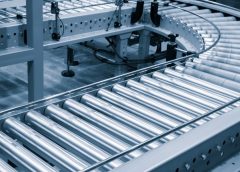Transporting products from one stage of production to another is crucial for your business’s operational efficiency. One of the most common ways to achieve this is by using conveyor belts. There are various types of conveyor belts, and their benefits make them an indispensable component in many industries. Explore some conveyor belt types below and how they provide value in different applications.
Flat Belt Conveyors
Flat belt conveyors are one of the most common and versatile types of conveyor belts. A continuous loop of flat belts made of rubber, fabric, or synthetic materials moves products and materials with the help of two or more pulleys. Flat belt conveyors are suitable for a wide range of applications, such as food processing, packaging, and manufacturing industries. They offer easy-to-clean designs and low maintenance, making them an ideal choice for many businesses.
PVC Belting
Polyvinyl Chloride (PVC) is a popular material in the construction of conveyor belts due to its durability, low weight, and versatility. PVC belting offers excellent resistance to abrasion, wear, and chemicals, making it suitable for various industrial applications, including mining, food processing, and pharmaceuticals. Additionally, PVC conveyor belts can increase the capacity of your conveyor system because they are less likely to damage, stretch, or experience slippage.
Modular Plastic Belting
Modular plastic belting is another valuable option among types of conveyor belts. This belting is composed of interlocking plastic modules, which offer flexibility, easy cleaning, and quick repairs. These conveyor belts are particularly suitable for food and beverage industries, where hygiene is a top priority. Modular plastic belts are also widely used in automotive assembly lines, pharmaceutical manufacturing, and packaging systems.
Belt-Over-Roller Conveyor
Belt-over-roller conveyor systems combine the benefits of roller-based and belt conveyors. These systems feature a series of rollers with a belt placed over them, providing more cushioning to handle delicate products or fragile packaging. They offer quiet operation and smooth product handling, making them ideal for industries like electronics, package distribution, and warehouse facilities.
Inclined and Declined Conveyor Belts
Transporting products along an inclined or declined path can be challenging for many conveyor systems. However, inclined and declined conveyor belts are designed specifically for this purpose. Using specialized belt material or cleats to prevent slippage, these conveyors allow businesses to efficiently move products uphill or downhill. Industries such as agriculture, mining, and construction benefit greatly from this type of conveyor system.
Understanding the various types of conveyor belts and their benefits is crucial for selecting the right system to meet your specific industry requirements. Choosing a conveyor belt that suits your needs can enhance operational efficiency, optimize productivity, and boost your business’s bottom line.


